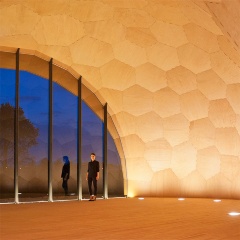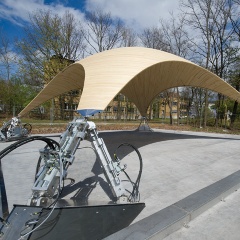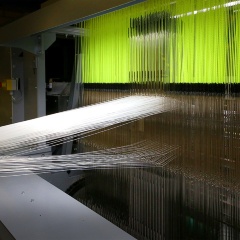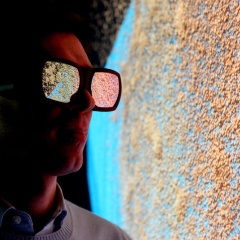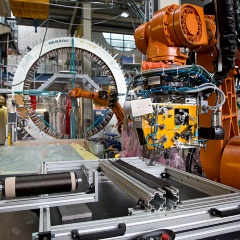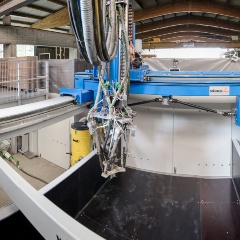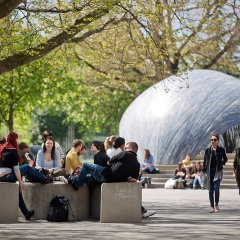Faculty 1 - Architecture and Urban Planning
The focus of the program is on designing as a creative process for solving complex social challenges on the basis of an open discourse on aesthetic concepts, technical innovations and the significance of ecological and economic questions. The development of an integrated understanding of design requires fundamental knowledge and the ability to work in interdisciplinary cooperation, acquired in close connection with research and practice.
Participating Institutes
- Institute for Architectural History (IFAG)
- Institute of Building Construction (IBK)
- Institute for Building Materials, Building Physics, Building Systems and Design (IBBTE)
- Institute for Computational Design and Construction (ICD)
- Institute of Landscape Planning and Ecology (ILPÖ)
- Institute for Building Structures and Structural Design (ITKE)
Faculty 2 - Civil- and Environmental Engineering
Civil and environmental engineers are in charge of designing both the build and natural environments. Civil and Environmental Engineers use resources and produce durable goods, which have to be operated and maintained over long periods of time, as well as renewed at the end of their life cycle.
Civil Engineering involves important responsibilities and aspects in the technical implementation and the use of the designed and constructed facilities such as human health, environmental impacts, aesthetics, economics of construction and life cycle assessments. Last but not least, Civil and Environmental engineering is characterized by its broad and diverse fields, as well as by its interdisciplinary collaboration with other engineers, mathematicians, computer scientists, as well as natural scientists, legal experts, and economists.
Participating Institutes:
- Institute of Construction Management (IBL)
- Institute of Structural Mechanics (IBB)
- Institute for Acoustics and Building Physics (IABP)
- Institute of Lightweight Structures and Conceptual Design (ILEK)
- Institute of Construction Materials (IWB)
Faculty 4 - Energy-, Process- and Bio-Engineering
Faculty 4 encompasses the fields of Energy-, Process- and Bio-Engineering and co-operates with Faculty 7, the second faculty for Mechanical Engineering in the fields Engineering Design, Production Engineering and Automotive Engineering.
Participating Institutes:
Faculty 5 - Computer Science,
Electrical Engineering and Information Technology
The departments of Computer Science and Electrical Engineering cover the entire spectrum of information and communication technologies, with additional emphasis on automation, sustainable energy and electromobility. We are very committed to collaborative research and teaching, and follow a strong interdisciplinary approach.
Participating Institutes:
Faculty 6 - Aerospace Engineering and Geodesy
The faculty is in an internationally outstanding position because of the way it connects fundamental aviation technologies, space travel, and geodesy. It is nationally the only aviation and aerospace engineering faculty at a public university; the combination with geodesy is also nationally unique. Its strong focus on teaching fundamental principles, combined with targeted, practice-oriented areas of specialization, creates a distinctive profile that counts as a mark of quality in Stuttgart’s research and industry sectors.
The approximately 2000 students of aerospace engineering and geodesy also learn about the interdisciplinary research areas of aviation technology, aircraft development, propulsion systems, avionics, spacecraft ascent and re-entry, satellite technology, and earth observation. The theses developed in these areas cover a wide range of topics, including mission analysis, flight control, aerodynamics, thermodynamics, material development, structural development, construction design, system development, and the operation and combustion of air-breathing propulsion systems.
Participating Institutes:
Faculty 7 - Engineering Design,
Production Engineering and Automotive Engineering
The Faculty of Mechanical Engineering consists of the faculties of energy technology, construction and production engineering, process engineering and technical cybernetics. The new structure is the key to a successful competitive environment. The mechanical engineering faculties hold the enormous research and training potential of 40 university institutes. The large number of institutes forms the backbone of interdisciplinary cutting-edge research and future-oriented engineering training at the highest level. The faculty's diversified structure generates strength and innovation to successfully compete with universities and industry.
Participating Institutes:
- Institute of Human Factors and Technology Management (IAT)
- Institute for Engineering Design and Industrial Design (IKTD)
- Institute of Machine Components (IMA)
- Institute for Control Engineering of Machine Tools and Manufacturing Units (ISW)
- Institute for System Dynamics (ISYS)
- Institute of Engineering and Computational Mechanics (ITM)
- Institute of Applied Optics (ITO)
Faculty 10 - Management, Economics and Social Sciences
The faculty's task is to achieve advances in knowledge in the economic and social sciences that take account of this increasing social complexity. In this context, the research activities focus on the University of Stuttgart's central research priorities "Complex Systems and Communication" and "Modelling and Simulation Technology", as well as on the resulting priorities "Mobility" and "Design of Sustainable Habitats", Research objects such as companies, markets, national economies, political and educational organisations as well as sports organisations can be understood as social systems in which people are involved in a communicative way in the form of psychological and biological systems. The description, explanation and target-oriented control of these complex social, psychological and biological systems is the common core of the faculty's research. Depending on the problem, the research activities are carried out in the form of individual research as well as interdisciplinary and interdisciplinary collaborative research.


